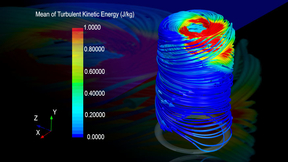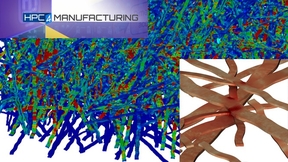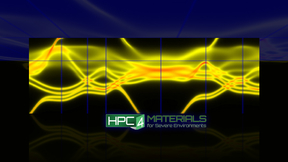Back
Computing
Lawrence Livermore scientists link up with Global Women in Data Science conference
Lawrence Livermore National Laboratory's (LLNL) High Performance Computing Innovation Center hosted a regional event on Mach. 5 tied in with Stanford University’s annual Women in Data Science (WiDS) conference. Nearly 70 attendees, mostly women Livermore and Sandia national laboratory employees, heard featured talks by female LLNL scientists on machine learning and data…
DOE seeks industry partners for HPC research on materials in applied energy technologies
The Department of Energy (DOE) today announced a funding opportunity totaling $3 million to support projects between U.S. industry and DOE national laboratories related to improving materials in severe or complex environments through the new High Performance Computing for Materials in Applied Energy Technologies (HPC4Mtls) Program. The call for proposals is the first…
DOE, VA meet to address veterans' challenges through supercomputing technologies
Officials and top scientists with the Department of Energy (DOE), Department of Veterans Affairs (VA) and several national labs gathered at Lawrence Livermore National Laboratory (LLNL) earlier this month for a two-day event to discuss using supercomputing, machine learning, artificial intelligence and other emerging technologies to solve major challenges facing veterans…
LLNL/U.K. officials ink agreement to collaborate on HPC research, ensure competitiveness
Lawrence Livermore National Laboratory (LLNL) and the United Kingdom’s governing body for scientific research on Monday announced the signing of a new three-year agreement aimed at improving U.S. and U.K. industries through high performance computing, promoting research collaborations and boosting economic competitiveness in the two countries. Officials from LLNL, the…
Hayward fault earthquake simulations increase fidelity of ground motions
In the next 30 years, there is a one-in-three chance that the Hayward fault will rupture with a 6.7 magnitude or higher earthquake, according to the United States Geologic Survey (USGS). Such an earthquake will cause widespread damage to structures, transportation and utilities, as well as economic and social disruption in the East Bay. Lawrence Livermore (LLNL) and…
DOE's HPC4Manufacturing program seeks industry proposals for energy advances
The Department of Energy (DOE) on Feb. 1 announced up to $3 million will be available to U.S. manufacturers for public/private projects aimed at applying high performance computing to industry challenges for the advancement of energy innovation. The funding represents the latest round of solicitations for the High Performance Computing for Manufacturing (HPC4Mfg) program,…
DOE announces first awardees for new HPC4Materials for 'Severe Environments'
The Department of Energy’s (DOE) Office of Fossil Energy (FE) today announced the funding of $450,000 for the first two private-public partnerships under a brand-new initiative aimed at discovering, designing and scaling up production of novel materials for severe environments. The projects are the first to receive funding under the HPC4Materials for Severe Environments …
DOE announces funding for new HPC4Manufacturing industry projects
The Department of Energy’s (DOE) Advanced Manufacturing Office (AMO) today announced the funding of $1.87 million for seven new industry projects under an ongoing initiative designed to utilize DOE’s high-performance computing (HPC) resources and expertise to advance U.S. manufacturing and clean-energy technologies. The projects mark the fourth round of awardees under the…
Student's essay on impact of LLNL summer internship wins scholarship award
Cal-State University Long Beach student Kalvin Ogbuefi, who interned last summer for Lawrence Livermore National Laboratory’s (LLNL) Data Science Student Institute (DSSI), recently won a $1,000 grand prize scholarship from the university for an essay about how his internship impacted his life. As a research intern, Ogbuefi was part of the Lab’s Machine Learning Group,…
INCITE awards LLNL researchers with computing time at Argonne, Oak Ridge
Lawrence Livermore National Laboratory (LLNL) scientists and researchers were among those awarded dedicated time on supercomputers at Argonne and Oak Ridge national laboratories under a Department of Energy program aimed at supporting computationally intensive, large-scale research projects. LLNL physicist Vasily Bulatov is heading a project that will use large-scale…
Lab-led HPC for Manufacturing project wins 'Innovation Excellence' award at SC17
An HPC for Manufacturing project aimed at saving time and money for paper product manufacturers earned an HPC Innovation Excellence Award at the 2017 SuperComputing Conference (SC17) in Denver on Nov. 14. The project, led by LLNL researcher Will Elmer, was a collaboration with consumer goods manufacturer Procter & Gamble and required the development of a parallel…
SC17 recap: LLNL's Computation contingent scales new heights in the Mile High City
The 2017 SuperComputing Conference (SC17), the world’s largest gathering of scientists, researchers and vendors in high-performance computing (HPC), descended on Denver last week, as nearly 13,000 people crammed the Colorado Convention Center over six days to learn about and discuss the latest advances in HPC, artificial intelligence (AI) and machine learning. A hot topic…
Siting Sierra: Lawrence Livermore's newest and fastest supercomputer is taking shape
Work is moving fast and furious in the Livermore Computing Complex at Lawrence Livermore National Laboratory (LLNL), where siting and installation for Sierra, the Lab’s next advanced technology high-performance supercomputer, is kicking into high gear. Trucks began delivering racks and hardware over the summer for what will eventually be a 125-petaFLOPs (floating point…
HPCwire awards Lab scientists at SC17
Lawrence Livermore National Laboratory (LLNL) researchers won big at the 2017 SuperComputing Conference (SC17) in Denver, taking home two HPCwire Editor’s Choice awards for their work in applying high-performance computing (HPC) to solve complex challenges. The publication honored Lab scientists involved in a partnership between the Department of Energy (DOE) national…
Public-private consortium aims to cut preclinical cancer drug discovery from six years to just one
Lawrence Livermore National Lab, Frederick National Laboratory for Cancer Research, GSK and University of California, San Francisco will combine vast data stores, supercomputing and scientific expertise to reinvent discovery process for cancer medicines. SAN FRANCISCO, Oct 27, 2017 -- Scientists from two U.S. national laboratories, industry and academia today launched an…
'Girls Who Code' workshop introduces students to 3D printing, computer-aided design
Granada High School sophomore Sehar Khan wants to be a professional wrestler when she grows up. But if that doesn’t pan out, she has a contingency plan. "Engineering is really fun," Khan said. "You can be creative and you have the freedom and choice to do what you want, and I like that. I want to learn more about different types of engineering pathways; if I can get the…
A quicker, picker upper? Lab researchers eye papermaking improvements through HPC
With the naked eye, a roll of paper towels doesn’t seem too complicated. But look closely enough, and you’ll see it’s made up of layers of fibers with thousands of intricate structures and contact points. These fluffy fibers are squeezed together before they are printed in patterns, and this resulting texture is key to the paper’s performance. For a large paper product…
LLNL project aims to transform electrical grid resiliency with distributed energy resources
In the event of a major earthquake, hurricane or flood, electricity might be lost for days, affecting communications, recovery efforts and people’s lives. Normally, in a large-scale emergency, distributed energy resources (DERs) -- such as the energy produced by solar panels at customers’ homes -- are shut off to protect the greater electrical grid. But a new project…
Lab leads new effort in materials development
Lawrence Livermore National Laboratory (LLNL) will be part of a multi-lab effort to apply high-performance computing to U.S.-based industry’s discovery, design and development of materials for severe environments under a new initiative announced today by the Department of Energy (DOE). The High Performance Computing for Materials Program (HPC4Mtls) will connect industry…
New Livermore Lab Foundation supports scientific advancement through philanthropy
The recently launched Livermore Lab Foundation (LLF) represents a new opportunity to support scientific advancement. LLF was formed to generate philanthropic backing of scientific research, technological development and educational outreach activities at Lawrence Livermore National Laboratory (LLNL). LLF is a 501(c)(3) tax-exempt charitable organization that can accept…

























